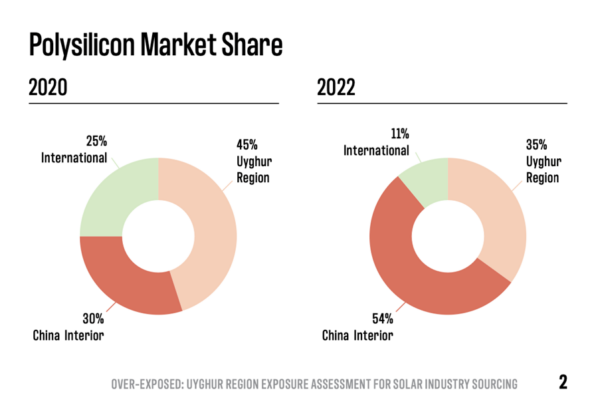British researchers, from Sheffield Hallam University, have published a second report on the alleged utilization of forced labor in the solar industry in the Xinjiang Uyghur Autonomous Region (XUAR), in China. The report finds falling levels of XUAR polysilicon and raw materials in the solar supply alongside a diminishing level of transparency.
The report “Over Exposed: Uyghur Region Exposure Assessment for Solar Industry Sourcing” is not a peer-review study. However, it goes into considerable detail in analyzing the complex solar supply chain. It describes the exposure to using polysilicon or silicon metal, otherwise known as metallurgical grade silicon, manufactured in the XUAR by several major Chinese solar module manufacturers, as well as non-Chinese manufacturers that have parts of their supply chain located in China.
The report finds that the share of polysilicon manufactured in the XUAR and used in solar module production has dropped from 45% in 2020 to 35% in 2022. Polysilicon analyst Johannes Bernreuter contributed to the report. He anticipates that this share will decline to approximately 28% to 32% “in the coming years.

While the share of XUAR produced polysilicon falls, it appears to be being replaced by locations elsewhere in China, such as Inner Mongolia. The research found that polysilicon produced in interior China increased from 30% in 2020 to 50% in 2022, with the share of international markets dropping, somewhat surprisingly, from 25% to 11%.
The share of silicon metal, from which polysilicon is made, is also falling – the report notes. Although it remains high, accounts for 45% of China’s silicon metal production or 32% of global output.
“Despite the decline in the region’s share of the world’s production, the Uyghur Region’s continued dominance in the production of materials essential to the manufacture of more than 95% of solar modules represents significant exposure to state-imposed forced labor for the industry,” the report reads. It notes that the Uyghur Forced Labor Prevention Act (UFLPA), enacted by the U.S. government at the end of 2021, banned all imports from China’s Xinjiang region, unless it can be proven that products were not made with forced labor.
The report also claims that, although big manufacturers are seeking to resort to supply chains that are reportedly free of solar products made in XUAR, they continue to source from suppliers or sub-suppliers that continue to rely on shipments from this region.
“Some of the world’s largest module manufacturers appear to have bifurcated their supply chains in an effort to create a product line that is free of XUAR inputs,” the Sheffield researchers write. “Most companies have suggested that these supply chains are dedicated to the US market or designed with UFLPA compliance in mind. The portion of modules that is made on these dedicated supply chains does not appear to exceed 12% of any company’s production capacity.”
This bifurcation of supply chains is potentially problematic, it is argued in the new report. While providing some evidence of supply chains outside of the XUAR production sites, it is very difficult to verify – as metal silicon or polysilicon supplies can be blended.
“Bifurcation of solar module supply chains presents a significant challenge to the wide range of governments, developers, and consumers purchasing modules, as they cannot always be certain whether they are buying the tainted or untainted products.”
Alongside the accusations of forced labor, the report provides an additional motivation for buyers to source products outside of the XUAR. It notes that every polysilicon plant in the region is 100% powered by coal – due to its abundance, “resulting in a very high carbon footprint and very low price.”
This content is protected by copyright and may not be reused. If you want to cooperate with us and would like to reuse some of our content, please contact: editors@pv-magazine.com.










By submitting this form you agree to pv magazine using your data for the purposes of publishing your comment.
Your personal data will only be disclosed or otherwise transmitted to third parties for the purposes of spam filtering or if this is necessary for technical maintenance of the website. Any other transfer to third parties will not take place unless this is justified on the basis of applicable data protection regulations or if pv magazine is legally obliged to do so.
You may revoke this consent at any time with effect for the future, in which case your personal data will be deleted immediately. Otherwise, your data will be deleted if pv magazine has processed your request or the purpose of data storage is fulfilled.
Further information on data privacy can be found in our Data Protection Policy.